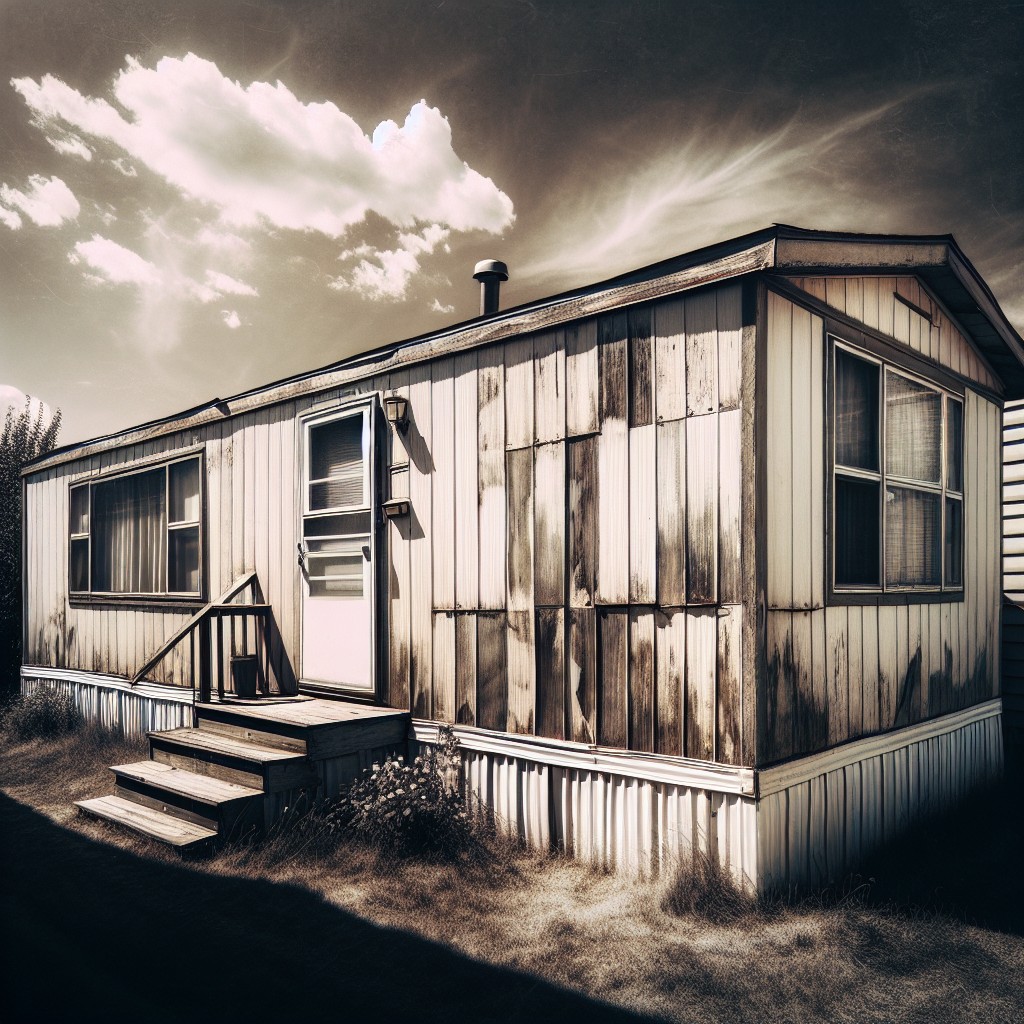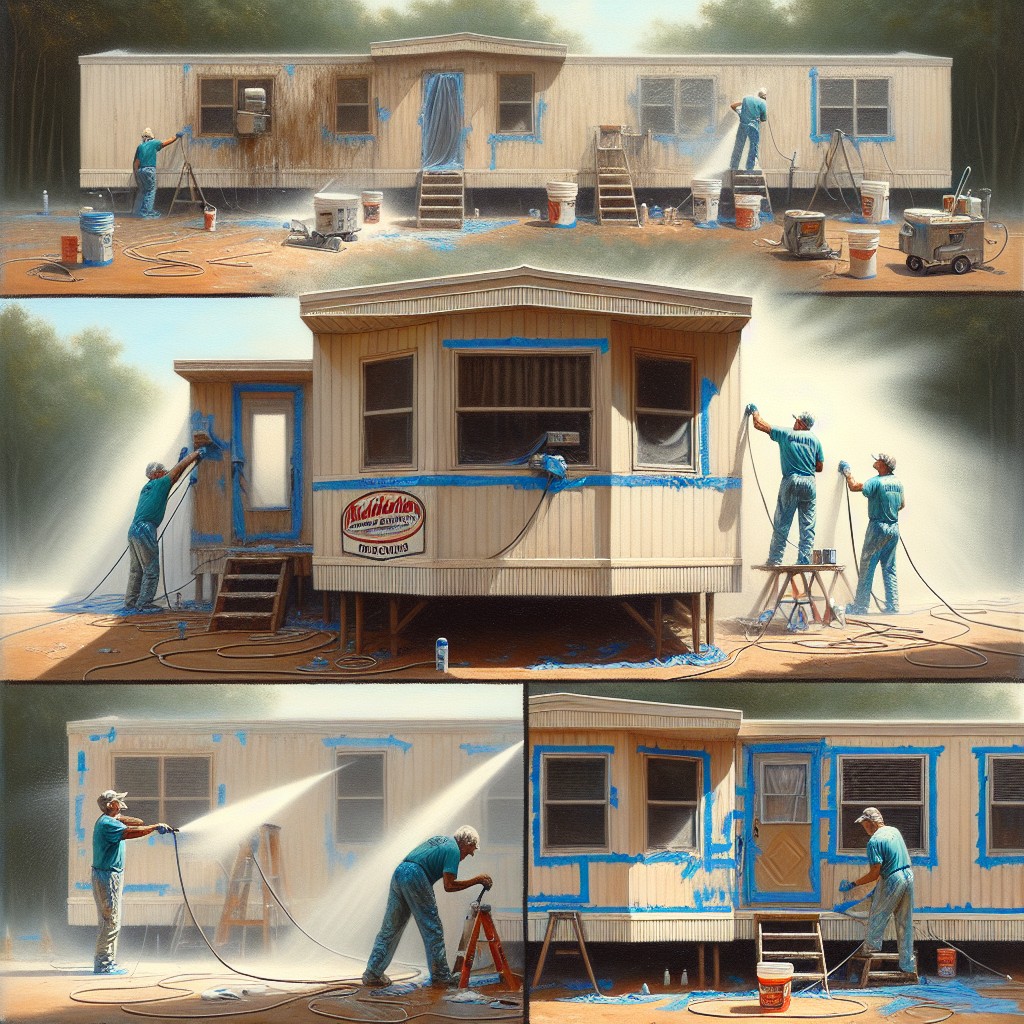Last updated on
Yes, you can paint a mobile home to improve its aesthetic appeal or protect it from the elements.
Certainly, painting a mobile home isn’t just feasible, it’s a fantastic way to completely refresh its appearance, protect it from the elements and increase its value.
Not only will this article guide you through the entire process, but it also offers tips and tricks for choosing the right paint, understanding the weather considerations, preparing the surfaces, applying the paint, and final touches.
Just like any other home, with the right information and equipment, a fresh coat of paint can transform your mobile home into a residence you can be proud of.
Stay tuned if you’re planning to undertake a DIY mobile home painting project, as the following paragraphs are filled with essential information you’ll need for a successful endeavor!
Key takeaways:
- Assess the condition of your mobile home siding before painting
- Thoroughly prepare the mobile home for painting
- Follow step-by-step instructions for painting metal siding
- Choose the right paint for metal siding
- Consider the advantages and challenges of spray painting vs. brush painting metal siding
Assessing the Current Condition of Mobile Home Siding

Before diving into the painting process, it is crucial to evaluate the condition of your mobile home siding meticulously. Look for signs of damage such as dents, scratches, or rust, especially if you have metal siding. For vinyl or wood siding, check for warping, rot, or mold growth. This step is essential because paint adheres best to surfaces that are smooth and free from imperfections.
Also, consider the age of your mobile home. Older homes may require more prep work, such as sanding or using a specially formulated primer to ensure proper paint adhesion. Observe the color fade patterns as well—darker patches could signify previous repairs or paint jobs, which might necessitate a different approach to ensure a uniform finish.
Lastly, assess previous paint layers. If the existing paint is peeling or bubbling, this indicates poor adhesion or moisture issues that must be addressed before applying new paint. Neglecting these details could lead to premature wear of your new paint job, so take the time to do a thorough assessment.
Preparing the Mobile Home for Painting

Before diving into the painting process, thorough preparation is key to ensuring the best outcome.
Remove any shutters, hardware, or fixtures that might impede the paint application or get damaged.
Use a high-pressure washer or a combination of soap and water with a sponge to cleanse the siding of any dirt, mildew, or grime.
For stubborn areas, a solution of bleach and water can help eliminate mold or mildew, but remember to protect landscaping from runoff.
Next, inspect the exterior for damage.
Seal any cracks or holes with a suitable exterior-grade caulk to prevent moisture penetration and ensure a smooth surface.
If there’s existing peeled or chipped paint, scrape it off and sand the area lightly for a consistent, ready-to-paint surface.
It’s crucial to let the home dry completely after washing and repairs, which can take several days depending on the weather conditions.
Remember, patience during the preparation stage pays off with a professional-looking finish.
Step-by-Step Guide: How to Paint Metal Siding On a Mobile Home

Begin by thoroughly washing the siding with soapy water and a soft-bristle brush to remove dirt, grime, and any loose paint. Rinse well and allow the surface to dry completely.
For rusty areas, use sandpaper or a wire brush to scrape away corrosion. Apply a rust-inhibiting primer to these spots to prevent further damage.
Cover windows, doors, and trim with painter’s tape and drop cloths to protect them from drips or overspray.
Cut in around edges and fixtures with a paintbrush to ensure precise application in these harder-to-reach areas.
Use a paint roller or sprayer to evenly apply an exterior acrylic latex paint formulated for metal surfaces. Begin at the top and work your way down to prevent drips on freshly painted areas.
Apply paint in thin, even coats to avoid runs or sags. Multiple light coats are preferable to a single heavy coat and will result in a more durable finish.
Allow the first coat to dry as directed by the paint manufacturer before applying a second coat, ensuring full coverage and a uniform appearance.
Check for any missed spots or touch-ups needed once the second coat is nearly dry, using a brush for precision.
By following these steps, you can refresh the look of your mobile home and protect its siding against the elements.
Choosing the Right Paint for Metal Siding

Selecting an appropriate paint for metal siding is critical to ensure longevity and durability. Aim for 100% acrylic latex paint, known for its resilience and adaptability to temperature fluctuations. This type of paint provides a flexible finish that resists peeling and cracking.
Opt for a paint with built-in primer to achieve strong adhesion to the metal surface, simplifying the process. If the siding has rust issues, consider a paint with rust-inhibitive properties to prevent further corrosion.
For energy efficiency, look for products with reflective pigments, especially in lighter colors, to reduce heat absorption and protect the siding from UV rays.
Finally, choose a paint with a high-quality finish – gloss, semi-gloss, or satin. Glossier finishes tend to be more durable and easier to clean, an important feature for the exterior of a mobile home exposed to the elements.
Tools and Supplies for Painting Metal Siding
Having the right set of tools and supplies is essential for a smooth painting job on your mobile home’s metal siding. Firstly, choose a paintbrush with synthetic bristles or a roller with a medium-nap cover; these are designed to handle the texture of metal surfaces and give you an even coat. When covering larger areas, a paint sprayer can drastically reduce the time and effort needed, but it requires some practice to perfect the technique.
You’ll also need a high-quality acrylic primer specifically formulated for metal. This will ensure proper adhesion of the paint to the metal siding and improve the longevity of your paint job. Painter’s tape is indispensable for protecting windows, doors, and trim from accidental splashes.
Additionally, you will need a ladder or scaffolding to safely reach higher sections, as well as drop cloths or plastic sheeting to protect the ground and nearby vegetation. Safety gear, such as goggles and masks, will protect you from paint fumes and particles. Lastly, have a good supply of rags and cleaners for wiping down surfaces and cleaning up any spills. With these tools and supplies at hand, you’ll be equipped to create a fresh, long-lasting finish on your mobile home’s metal siding.
Cleaning and Priming the Metal Siding
Before applying primer, a thorough cleaning is essential to ensure proper paint adhesion. Begin by washing the siding with a mix of water and a mild detergent, scrubbing gently with a soft-bristled brush to remove grime, mildew, and chalky residue.
Once the surface is clean, rinse it well with water to remove all detergent traces. Allow the siding to dry completely before moving on to the priming process, as moisture trapped beneath the paint can cause peeling and other issues.
Selecting a high-quality primer is crucial, especially one that’s formulated for metal surfaces and exterior use. This will aid in protecting the siding against rust and ensure a smoother, more uniform paint application. Apply the primer according to the manufacturer’s instructions, using even, long strokes and taking care to cover every inch of the surface.
Allow the primer to dry as advised on the product’s label. This step is vital as it guarantees the primer has set properly, providing a solid foundation for the topcoat of paint. After the primer is dry, you’re ready to move on to painting, which will seal the deal on your mobile home’s fresh new look.
Applying Paint: Techniques and Tips
Achieving a smooth and long-lasting finish hinges on using the right techniques:
1. Light Coats: Apply paint in thin, even layers. This prevents drips and improves drying time, ensuring a more uniform appearance.
2. Consistent Direction: When using a brush or roller, paint in one direction – horizontal or vertical – to minimize visible brush strokes.
3. Overlap Strokes: Overlap each pass slightly to avoid missed patches and help blend each stroke seamlessly with the next.
4. Dry Times: Adhere strictly to the manufacturer’s recommended drying times between coats to avoid tackiness and to ensure good adhesion.
5. Edge First: Tackle the edges and corners before painting larger panels. This technique, known as “cutting in,” ensures full coverage and helps maintain clean lines.
Remember, patience and attention to detail will reward you with a professional-looking finish that enhances the longevity and appeal of your mobile home.
Spray Painting Vs. Brush Painting Metal Siding
When tackling the task of adding a fresh coat of paint to your mobile home’s metal siding, two common methods stand out: spray painting and brush painting. Each offers distinct advantages and challenges.
Spray Painting Advantages:
- Uniform coverage: Provides a smooth, even coat, particularly on metal surfaces.
- Apt for large areas: Allows for quicker coverage of expansive surfaces.
- Less labor-intensive: Reduces the physical effort required compared to brushing.
Spray Painting Challenges:
- Equipment cost: Requires a sprayer, which can be pricey.
- Technique sensitive: Demands steady hand movement to avoid drips and uneven application.
- Overspray concerns: Paint can drift, affecting nearby surfaces and requiring additional prep work.
Brush Painting Advantages:
- No need for complex equipment: Only brushes or rollers required, which are relatively inexpensive.
- Enhanced control: Offers more precision around edges and trims.
- Versatility: Easier to manage for small touch-up jobs or detailed work.
Brush Painting Challenges:
- Time-consuming: Takes longer to cover large areas.
- Physical effort: Can be strenuous, especially for siding with deep textures.
- Risk of marks: Brush strokes may remain visible if not applied evenly.
In choosing between these approaches, consider factors like the size of your mobile home, the complexity of the surface, and your proficiency with painting tools. Your choice can significantly affect the efficiency, appearance, and longevity of your paint job.
Safety Precautions When Painting a Mobile Home
Prioritize personal protection by wearing a mask, goggles, and gloves, especially when sanding and applying primer or paint to prevent inhalation of dust and fumes and to protect your skin and eyes. Ensure adequate ventilation if you are working in a confined space to reduce exposure to harmful vapors.
Utilize a stable ladder and maintain three points of contact when reaching higher sections of the mobile home to prevent falls. Keep the work area clear of obstacles, and lay down drop cloths to minimize slipping hazards and avoid paint spills.
Follow the manufacturer’s instructions for all paints, primers, and equipment. Some may require specific safety measures or application techniques. Store paint and flammable materials away from heat sources and dispose of paint-related materials safely according to local regulations.
Finally, be aware of the weather conditions; strong winds can cause ladders to be unstable and can interfere with paint application, while extreme temperatures can affect paint drying times and performance.
Estimated Costs: Paint and Supplies for Metal Siding
The cost of painting a mobile home varies depending on several factors such as the quality of paint chosen, the size of the mobile home, and whether you will DIY or hire professionals.
For a standard single-wide mobile home, anticipate purchasing around 10 gallons of paint, which might range from $250 to $600 depending on the brand and whether specialty paints are used. Primer, which is critical for ensuring adherence and longevity, can add an additional $100 to $200 to the total.
Aside from paint and primer, you’ll need brushes, rollers, paint trays, and painter’s tape for precise edges. These materials can cost between $50 and $150. If you opt for a paint sprayer to expedite the process and achieve a more uniform coat, renting one might cost about $70 to $100 per day.
Keep in mind that protective gear, such as safety glasses and masks, and cleaning supplies for preparation will also contribute to the overall cost, albeit minimally. In total, supplies alone will likely run between $400 and $850.
Consider the potential need for siding repairs before painting. If you have to replace panels or make significant fixes, this will increase costs and should be factored into the budget planning.
Lastly, professional services can vary greatly but expect quotes ranging from $1,000 to $3,000, including labor and materials. Always compare estimates and validate professional credentials before making a commitment.
When to Seek Professional Painting Services
Recognizing your limitations is crucial for a successful paint job. It might be time to call in the professionals if:
- The scope of the job exceeds your comfort level, especially when dealing with high places or extensive surface areas.
- There’s significant pre-painting work, such as repairing large sections of siding or extensive surface preparation, that goes beyond simple cleaning and priming.
- You lack the specific tools or equipment for safe and effective painting, like scaffolding for high exterior walls.
- The siding material is uncommon or requires specialized techniques or products, where professional expertise can prevent costly mistakes.
- Your schedule doesn’t allow for the dedication needed to complete the project in a timely manner – professionals can ensure it gets done quickly and efficiently.
- You’re looking for a warranty on the workmanship or the durability of the paint job, which many professional services offer.
In these situations, investing in professional services ensures a higher quality finish, safety throughout the process, and peace of mind.
Environmental Considerations in Painting a Mobile Home
Choosing environmentally friendly paints is not only good for the planet but also beneficial for your health. Opt for low or zero VOC (volatile organic compounds) paints, which reduce the release of harmful chemicals into the air during and after application. Additionally, water-based acrylic paints offer an easier cleanup process and less environmental impact compared to their oil-based counterparts.
Responsibly disposing of any leftover paint and materials is crucial. Never pour paint down the drain or into the ground. Check with your local waste management services for guidelines on recycling or disposing of paint products.
Consider the timing of your project to minimize environmental impacts. Painting during mild weather conditions can help ensure that the paint cures properly and reduces the likelihood of emissions getting trapped in the atmosphere due to temperature extremes.
Using brushes and rollers instead of spray painting can reduce overspray, which not only wastes paint but also contributes to atmospheric pollution. However, if you choose to spray paint, use a shield to contain the area and minimize the spread of aerosols.
By integrating these practices, you contribute to a more sustainable approach to home improvement, ensuring your mobile home’s fresh coat of paint goes hand in hand with environmental stewardship.
FAQ
Can I paint the walls in my mobile home?
Yes, you can paint the walls in your mobile home, but it’s important to properly prepare the surfaces to ensure a smooth and successful paint job.
Can you paint a mobile home exterior with a roller?
Yes, you can paint a mobile home exterior using a roller, specifically a 3/4 nap roller on a pole, along with a cut-in brush for detailed areas, with a recommended paint such as a Behr exterior latex flat or satin.
What kind of paint do you use on aluminum mobile homes?
For aluminum mobile homes, the recommended type of paint is acrylic latex due to its eco-friendliness, low chemical composition, and durability.
What preparation steps are necessary before painting a mobile home exterior?
Before painting a mobile home exterior, it’s necessary to clean the surface thoroughly, scrape off any loose paint, make any necessary repairs, sand for smoothness, and apply a suitable primer for adherence of the new paint.
What is the best technique to paint the vinyl walls of a mobile home?
The best technique to paint vinyl walls of a mobile home is by cleaning the walls thoroughly, gently sanding them to remove any gloss, applying a high-quality primer, and then using a latex or acrylic paint specifically designed for vinyl.
Is there a specific type of paint that’s more beneficial for the longevity and maintenance of a mobile home’s exterior?
Acrylic latex paint is ideal for a mobile home’s exterior due to its durability, flexibility during temperature changes, and ease of maintenance.
Table of Contents




